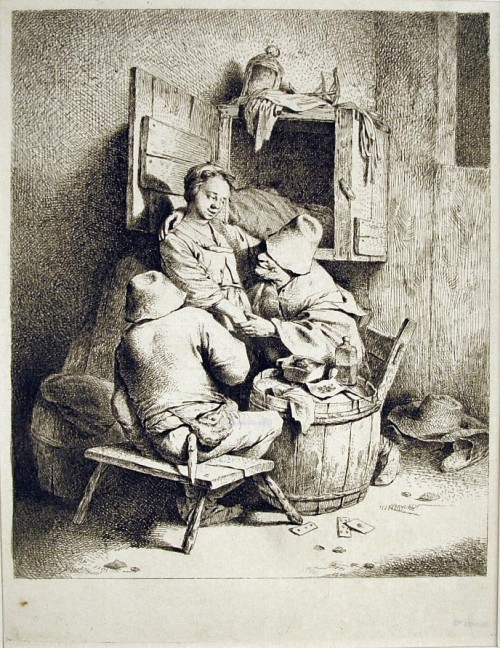Man Caressing the Young Hostess

Cornelis Bega (1631/32-64), Man Caressing the Young Hostess, ca. 1660-64, etching. Reference: Hollstein, Bartsch 34, first state of two, with the name of the artist showing in the lower left corner through the crosshatching. Printed on old laid paper with a dark brown ink, a partial crest watermark. In very good condition, borders inked in, trimmed on or outside of the platemark, 8 3/4 x 6 7/8.
A fine delicately printed early impression of this 17th Century Dutch masterpiece.
Provenance: ex Collection Dr. Karl Herweg, with his stamp verso (not in Lugt), and Coenrad Willem Antoine Buma (Lugt 494a, his initials in pencil verso). Dr. Herweg was a noted collector of 17th Century Dutch prints, especially those of Van Ostade and Bega; Buma was also noted for his collection of 17th C. Dutch prints.
Dr. Herweg purchased most of his old master print from CG Boerner in Dusseldorf, where he was advised by legendary connoisseur and scholar-dealer Eduard Trautscholdt whose real passion was the etchings of the Haarlem genre painter-etchers: Cornelis Bega, Adriaen van Ostade, and the latter’s pupil Cornelis Dusart. Working with Trautscholdt, Dr. Herweg collected meticulously and with great discernment, selecting the best impressions of diverse states, often buying a further impression of a print already acquired.
In this late stage of Bega’s career he typically grouped his figures tightly in a pyramidal cluster. Here the setting is rather austere, with various elements extending the middle grouping. The light comes from an undisclosed source, although some light may be coming from the lamp (above the cabinet) which serves as the apex of the composition.
The depiction of sex, drinking, smoking and gambling is both direct and symbolic. Obviously the two men are leering at and embracing the young barmaid – the one at the right is holding her hand; the one at the left is rocking toward her, and it’s not clear where his right hand is going. Cards are on the floor; the ace of spades could symbolize death, but the other cards have no special meaning. The pipe was typically shared in 17th C. Holland, and perhaps the bottle was too. The hat on the floor (which is superfluous since both men have hats) denoted irresponsibility; and the open cabinet with its wrinkled linens, and the empty shoes may refer to the sexual favor which is being arranged. But no great moralizing seems to be operative; the margin below the picture was not used for any message, at least among the known impressions.
(Note: for an interesting and detailed discussion of the iconography of this print see the catalogue Dutch Prints of Daily Life by Linda A. Stone-Ferrier, published by the Spencer Museum of Art, University of Kansas.)